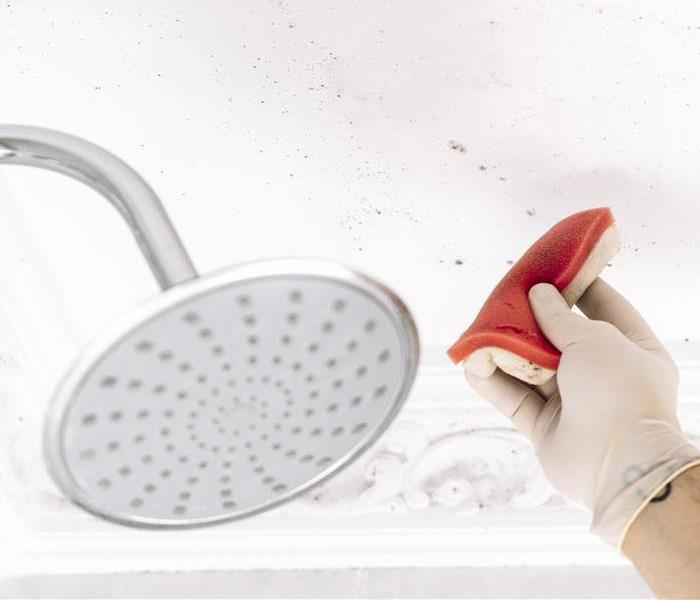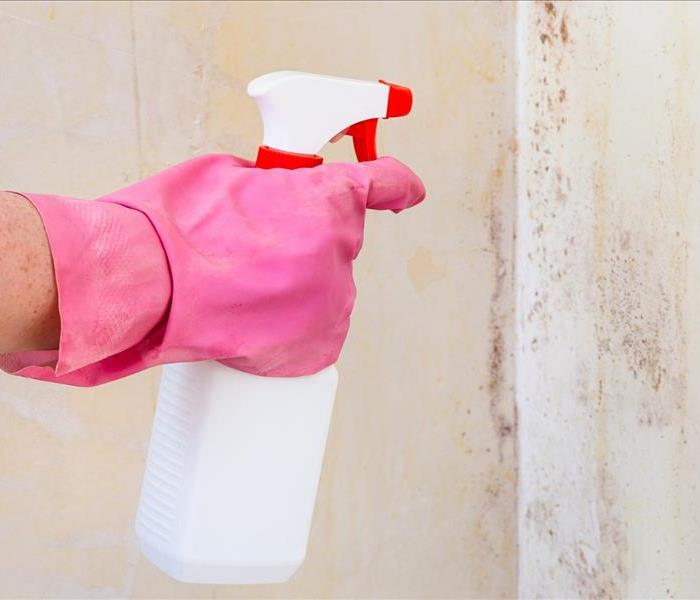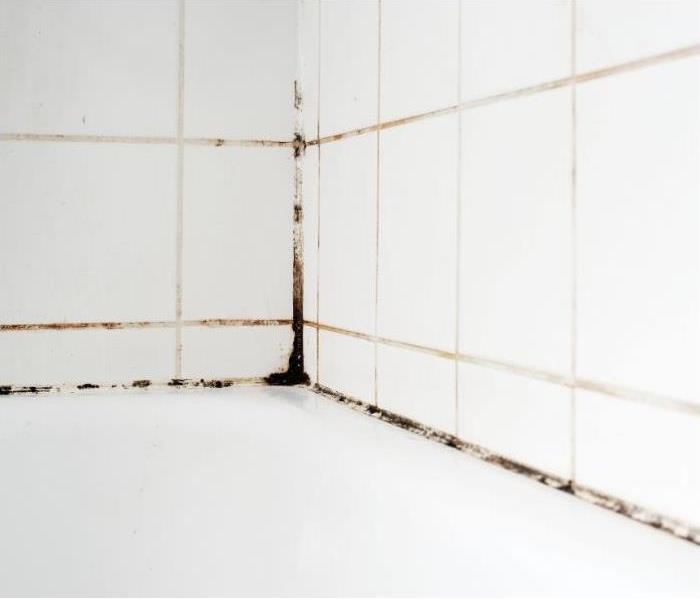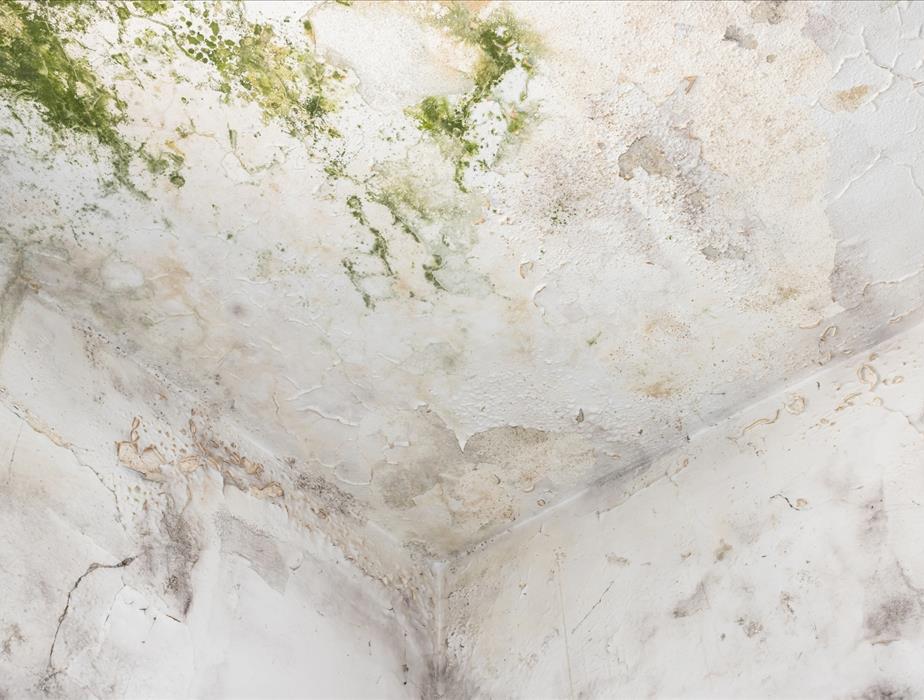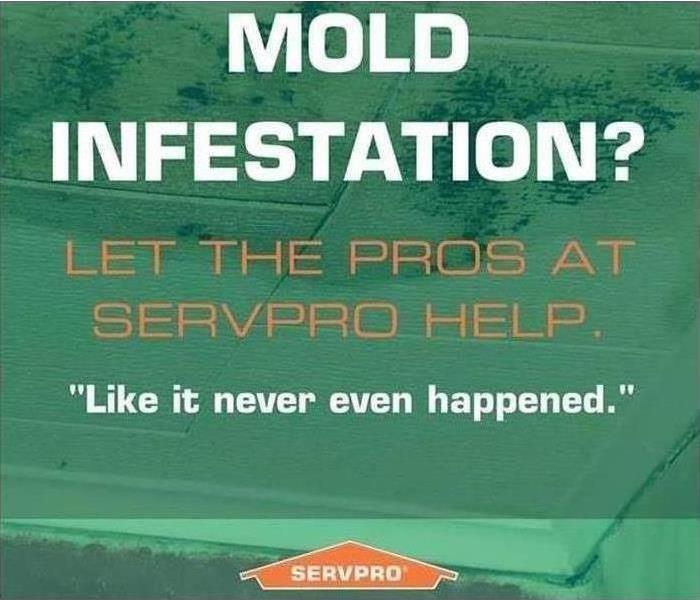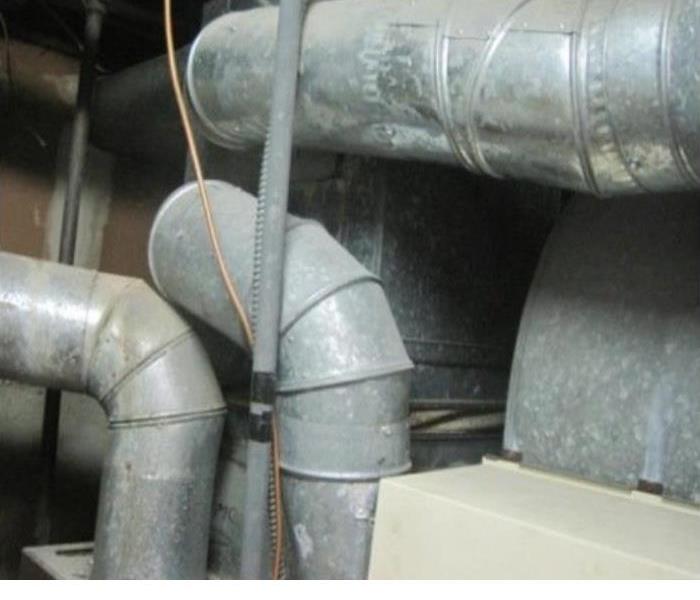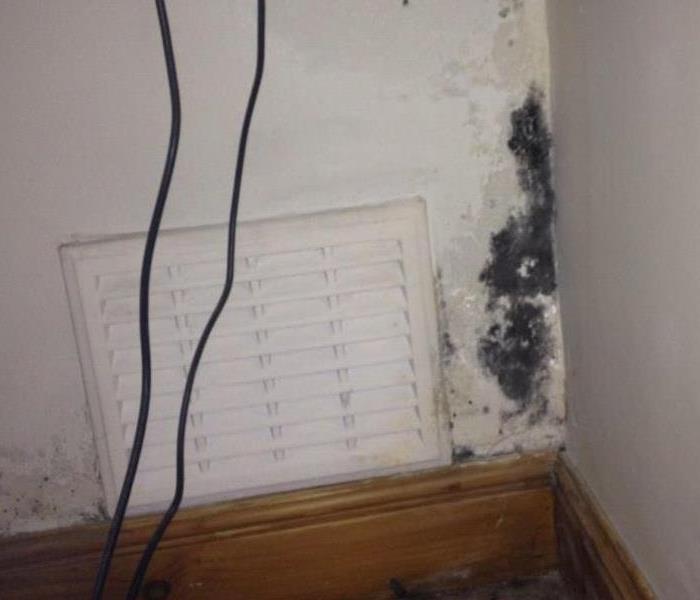Recent Mold Remediation Posts
Unmasking Mold: How to Recognize Signs of Mold in Your Home
11/25/2023 (Permalink)
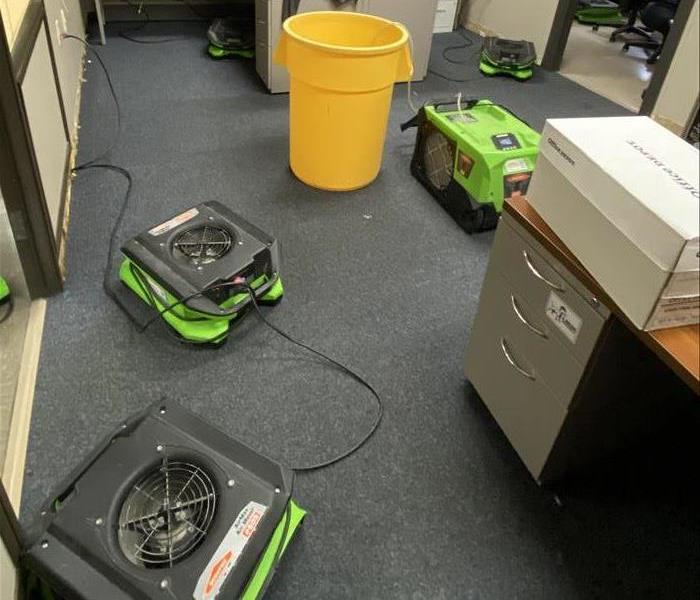 Preventing mold exposure by drying moisture exposed areas thoroughly
Preventing mold exposure by drying moisture exposed areas thoroughly
Mold, a common household intruder, can often remain hidden from plain sight, silently affecting your health and your home's integrity. Recognizing the signs of mold is the first step in addressing this issue effectively. In this blog post, SERVPRO shines a light on how to recognize the subtle and not-so-subtle signs of mold in your home.
1. Visual Clues:
The most apparent signs of mold are often visual in nature. Keep an eye out for:
- Discoloration: Mold can appear in various colors, including black, green, brown, white, or gray. It may present as splotches, streaks, or patches on walls, ceilings, or surfaces.
- Fuzzy or Powdery Texture: Mold often has a fuzzy or powdery appearance, especially on damp materials or in humid conditions.
- Stains and Water Damage: Stains, discoloration, or signs of water damage on walls, ceilings, or floors can be indicative of an underlying mold issue.
- Peeling Paint or Wallpaper: Mold can cause paint or wallpaper to peel or bubble, as it grows behind these materials.
2. Musty Odors:
Mold is known for emitting a distinctive, musty odor that can linger in your home. If you notice persistent, earthy, or unpleasant odors, especially in specific areas of your home, it may be a sign of hidden mold growth.
3. Allergic Reactions:
Mold spores can trigger allergic reactions in some individuals. If you or your family members experience unexplained symptoms such as sneezing, coughing, nasal congestion, eye irritation, or skin rashes that worsen when at home but improve when away, it could be due to mold exposure.
4. Health Symptoms:
Prolonged exposure to mold can lead to a range of health issues, including respiratory problems, headaches, fatigue, and more severe conditions in sensitive individuals. If you or your family members experience unexplained or worsening health symptoms while at home, consider the possibility of mold as a contributing factor.
5. Water Intrusion History:
If your home has a history of water leaks, flooding, or excessive moisture, it becomes more susceptible to mold growth. Even if you've addressed past water issues, residual moisture can create an environment conducive to mold development.
6. Hidden Areas:
Mold often thrives in hidden or less frequently visited areas, such as:
- Behind Walls: Mold can grow within wall cavities, particularly if there has been water damage or high humidity.
- Under Flooring: Mold can lurk beneath carpets, tiles, or wooden flooring.
- In Basements and Crawlspaces: These areas are prone to moisture issues, making them prime locations for mold growth.
7. Stale or Damp Air:
A home with poor ventilation or high humidity levels can provide an ideal breeding ground for mold. If you notice that the air in your home feels damp, stale, or excessively humid, it may promote mold growth.
Recognizing the signs of mold is crucial for addressing the issue promptly and effectively. If you suspect mold in your home, it's essential to seek professional assistance from SERVPRO. Our experienced technicians have the expertise and equipment to locate, assess, and safely remediate mold infestations, ensuring a safe and healthy living environment for you and your family. Your health and well-being are our top priorities, and we're here to support you every step of the way.
Can You Live in a Home with Mold in the Walls?
10/10/2023 (Permalink)
Living with mold in your home can be dangerous to your health. The sooner you get rid of it, the better. However, sometimes mold is hidden behind walls or in other places where it's difficult to spot. If you're not sure whether or not you have mold in your home, it's important to know the signs to look for.
Signs of Mold
If you notice a musty smell in your home, it's a good indication of the presence of mold. You might also see visible mold growth. It can appear as black, green, or white patches on walls, ceilings, or other surfaces.
If you presume mold, it's essential to have your home tested by a professional. They can take samples of the air or surface areas to be certain of its presence and help you determine the best way to get rid of it.
Getting Rid of Mold
Once you've confirmed that you have mold in your home, it's important to take action to get rid of it. Mold removal can be a challenging and costly process. However, it's important to do it correctly to ensure that it doesn't come back.
If you have a small amount of mold, you might be able to remove it yourself with household cleaners and a little elbow grease. However, if you have a large amount of mold, it's best to hire a professional. They have the experience and equipment necessary to safely and effectively remove mold.
Preventing Mold
There are a few things you can do to reduce the risk of mold growth in your home:
Control Humidity Levels
Mold thrives in moist environments. To prevent growth, keep the humidity level in your home below 60%. You can do this by:
- Using a dehumidifier
- Increasing ventilation
- Fixing any leaks
Reduce Indoor Temperature Fluctuations
Temperature fluctuations can also lead to mold growth. To prevent mold, try to keep indoor temperatures as consistent as possible.
Use an air conditioner or a fan when it's hot outside, and open up windows when it's cooler to help regulate the temperature inside your home.
Monitor Condensation
Condensation can also lead to mold growth. Therefore, it is important to monitor areas of your home that are prone to condensation, such as windows, walls, and ceilings.
If you see condensation, ventilate the area, or use a dehumidifier to help reduce the moisture in the air.
Clean Up Spills and Leaks Immediately
Spills and leaks are other common sources of mold. To prevent mold, clean up any spills or leaks as soon as possible. Mop up wet floors, wipe down wet surfaces and fix any leaks to help keep your home mold-free.
Use Mold-Resistant Products
There are a variety of mold-resistant products available on the market, such as:
- Paints
- Caulks and sealants
- Bathroom and kitchen tiles
- Mold-resistant drywall
When using mold-resistant products, be sure to follow the manufacturer's instructions to ensure they are used properly.
Treating Mold
If mold is already growing in your home, you'll need to treat it to prevent the problem from getting worse.
- Clean up any moldy surfaces with soap and water
- Use a commercial mold removal product
- Repair or replace any moldy materials
When treating mold, it's important to take precautions to avoid it spreading to other areas of your home. Be sure to:
- Wear adequate protection
- Open windows and doors to provide ventilation
- Cover any moldy surfaces with plastic sheeting before cleaning
- Clean up moldy materials outside whenever possible
Taking these precautions can help prevent the spread of mold and make the job easier.
When to Call a Professional
There are some cases where it's best to call a professional to handle the problem. If you have a lot of mold, or it's growing in a difficult-to-reach area, or if you have health problems that make you susceptible to mold, it's best to call a professional.
A professional will have the experience and equipment necessary to remove mold safely and effectively. They will also be able to help you identify and fix the source of the moisture to prevent the mold from coming back.
If you think you might have a mold problem, call SERVPRO of East Baton Rouge and Ascension at (225) 753-3434 to schedule a free assessment. We're here to help with your mold remediation needs.
3 Spots Mold Loves to Hide in Your Home
9/24/2023 (Permalink)
The presence of mold in your home can cause significant damage to both you and your belongings. Molds, being fungi, are destructive in nature. They appear and replicate quickly when an area becomes damp and humid. Molds can cause or exacerbate a wide variety of allergy symptoms in sensitive individuals. Some of these symptoms include coughing, wheezing, sneezing, itchy eyes, a runny nose, nasal stuffiness, and so on.
However, molds not only have a negative impact on human health, but they also cause a number of structural issues that, if left unchecked, can put you and your family in danger and destroy valuable possessions.
Because of this, you should always be on the lookout for mold and be ready to take immediate action against an infestation by finding its hiding places and contacting a mold remediation expert. Of course, you're probably already familiar with the obvious spots, but you may not have considered the hidden places where mold can grow rapidly without being noticed, and these are often the ones that lead to major problems and costly repairs in the home. But if you know what to look for and perform some basic home maintenance regularly, you can keep your home mold-free.
When inspecting your home for mold, here are the three (3) most important places to look:
In the Shower or Bathtub
Mold prefers and thrives in moist environments, so it can be found in poorly ventilated bathrooms and showers. Mold frequently grows in the grout between tiles and can be difficult to detect and remove. Make a habit of thoroughly scrubbing all surfaces on a regular basis. They are also commonly found on appliances that get damp from prolonged exposure to water. Keep your bathroom well-ventilated at all times, and if you're worried about mold but can't tell for sure, consider hiring a mold remediation expert to take a look around.
Get in touch with a qualified clean-up service, such as SERVPRO of East Baton Rouge and Ascension. Because of our extensive experience with mold remediation, we can quickly return your home to a healthy and safe condition.
In the Basement
Poorly lit and moist areas are the two primary factors mold needs to thrive, and basements are often damp and dark, which makes an ideal place for mold to grow. The dust that accumulates there, combined with the limited airflow, creates an ideal environment for mold to thrive. Check for leaks and moisture issues, and try to dry out the basement as much as possible.
In the Kitchen
Mold can grow in a variety of spots and areas throughout the kitchen. Mold loves to grow on food, so if you want to keep it from taking over your fridge or freezer, you should clean it out regularly.
Get rid of any food items that have gone bad or are past their expiration date. Dishes and the dishwasher are two more areas where you might be tempted to cut corners in an effort to save time, money, or both. For example, you might skip the dry cycle phase to get the dishwasher done more quickly and use less energy. When your dishes and dishwasher aren't properly dried, they become a breeding ground for mold. On the other hand, you might find mold growing in the cracks among your dishware stacked in the cupboard.
It is important to make sure that your food items are properly packaged and stored. Therefore, it is advisable to do regular checks to make sure that no perishables have gone bad or have expired and that no mold has grown.
Quick Signs of Mold's Presence
- Musty odor or damp and rotten smell
- Stained clothing
- Contaminated carpets
- Tainted tiles
- Distorted walls
If you have looked around your home and are experiencing some of these symptoms, you should get a mold check and have it cleaned up. When you detect a musty smell but can't figure out what it is, it's time to call a mold removal company.
Contact a professional remediation company like SERVPRO of East Baton Rouge and Ascension. We specialize in mold removal and can quickly restore your home to a safe and healthy state. For more information, please contact us right away!
Feel Sick in Your Own Home? Check for Mold
9/17/2023 (Permalink)
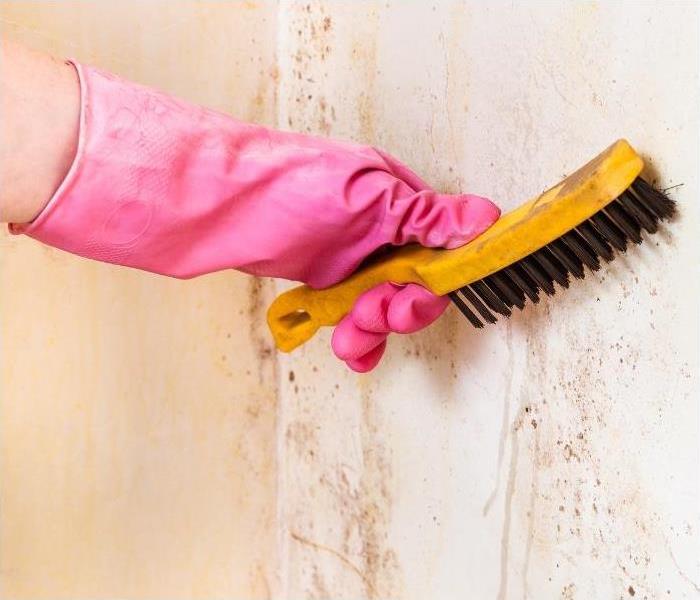 Typically, mold will grow on walls, ceilings, floors, upholstery, furniture, leather, wooden surfaces, cardboard, and insulation.
Typically, mold will grow on walls, ceilings, floors, upholstery, furniture, leather, wooden surfaces, cardboard, and insulation.
Mold is one of the most common household problems in both new and old homes. Mold can emerge in any kind of climate, but it is more likely to happen in warmer areas. Mold requires water and a relatively warm temperature to grow, and even in cold climates, the internal environment of the home can be suitable for mold growth. Getting rid of mold as soon as possible is the best strategy, as it can not only ruin your belongings but can also be a serious health risk.
Signs of Mold
If you can see mold, that is the easiest way to detect it. Generally, it will appear as dark dots or a powdery coating on a surface. Mold can grow in various places, so looking out for these signs in every part of the home is important. Typically, mold will grow on walls, ceilings, floors, upholstery, furniture, leather, wooden surfaces, cardboard, and insulation. Some of these places, such as insulation behind drywall, may not be visible.
A bad odor also accompanies mold growth. It smells like bad eggs or like something is rotting. Mold can often get into AC and HVAC units, leading to a bad smell all around the house.
The spores in the air will also lead to increased breathing problems and aggravate certain illnesses. People with especially sensitive sinuses and airways will feel aggravation in their system. It can also lead to eye irritation, coughing, nasal congestion, throat irritation, and even skin rashes if you come in contact with the mold. If these symptoms aren't improving, you may have a mold problem even though you can't smell it.
Where to Look for Mold
The first thing you should look for is discoloration. This could be on walls, floors, ceilings, or on individual items such as sofas or carpets. Discoloration could look like a powdery coating over the area or be in the form of black dots. The color and the kind of discoloration will vary depending on the kind of mold.
Also, have a look in places that are likely to develop moisture, such as near plumbing, pipe ducts, under the sink, or in the bathroom. If your home has recently experienced water damage, have a look at those places, as they may not have dried out fully and started to grow mold.
Also, look in places that don't get used too often or stay closed a lot, such as crawl spaces, basements, attics, drawers and cabinets, parts of the garage, or even unused spaces within the house.
Look at things that are sitting in storage, such as mattresses, cardboard boxes, extra clothing, shoes, and other items. If you have a pantry in the kitchen, go through all the belongings in that space to ensure mold isn't developing inside a container. Sometimes even airtight containers can be compromised.
How to Remedy the Situation
The most important step in mold remediation is to prevent it from spreading. Once you have located the mold, get in touch with SERVPRO professionals who can help you contain the mold. The mold remediation team at SERVPRO will close off that area and quarantine anything that needs to be treated. Then they will remove the affected belongings and start addressing the area. This involves closing off the area and removing the mold while ensuring that the spores do not spread to other places.
The affected space will need to be treated and then properly dried to remove moisture from the surface and the air in that space. SERVPRO has heaters and fans that are needed to properly dry out the space and specialized disinfectants and chemicals that are needed to deep clean the area where the mold was growing. SERVPRO of East Baton Rouge and Ascension is here to help! We offer comprehensive mold remediation services that will get your home back to normal, stop the mold in its tracks, and save your property and your health. Call us at (225) 753-3434 for a free consultation.
Bathroom Corners Keep Growing Mold?
9/1/2023 (Permalink)
Mold can be a big problem in any home, but it's especially troublesome in the bathroom. Because of the high humidity levels in this space, mold can easily take hold and grow rampant. If you've noticed that your bathroom corners keep growing mold, there are a few things you can do to combat the issue. But first, it's important to understand why this problem occurs.
Why Bathroom Corners Grow Mold
There are a few reasons why bathroom corners are more susceptible to mold growth than other areas of the home.
- The high humidity levels in your bathroom create the perfect environment for mold to grow. Mold loves warm, moist environments, and your bathroom provides that in spades. When you take a hot shower, the steam creates condensation on your walls, ceiling, and floors. This condensation provides the perfect opportunity for mold to take hold.
- Another reason why bathroom corners are more prone to mold growth is that they're often darker than other areas of the room. Because they don't get as much light, mold can more easily proliferate in these shadowy spots.
- Finally, bathroom corners tend to collect dust and other particles. These particles provide food for mold, which helps it to grow and spread.
How to Prevent Mold Growth in Your Bathroom Corners
Now that you know why your bathroom corners keep growing mold, you can take steps to prevent it from happening. Here are a few tips:
Use an Exhaust Fan: This will help to keep the humidity levels in your bathroom down, making it less hospitable for mold growth.
Wipe Down Wet Surfaces: After you take a shower, be sure to wipe down any wet surfaces in your bathroom. This includes your walls, ceiling, and floors.
Keep Things Clean: Be sure to clean your bathroom regularly. This includes sweeping and mopping the floors, wiping down surfaces, and cleaning the toilet.
Fix Leaks: If you have any leaks in your bathroom, be sure to fix them as soon as possible. Leaks provide a source of water for mold to grow.
Let in the Light: Mold loves dark, shadowy corners. So, if you can, let some light into your bathroom to help prevent mold growth.
Following these tips will help to keep mold from growing in your bathroom corners. However, if you already have a mold problem, you'll need to take steps to remove it.
How to Remove Mold from Your Bathroom Corners
If you already have mold growing in your bathroom corners, don't despair.
Find the Source
First, you'll need to identify the source of the moisture. Mold loves damp, humid conditions, so chances are there's a leaky pipe or other problem that's causing your bathroom corners to stay wet. Once you've fixed the source of the moisture, you can start cleaning up the mold.
Clean It Up
To remove mold, you'll need to use a solution of bleach and water. Mix one part bleach with 10 parts water, and apply it to the affected areas with a sponge or brush. Let it sit for about 15 minutes, then scrub away the mold and rinse the area with clean water.
Once you've removed the mold, take steps to prevent it from coming back. Make sure your bathroom is well-ventilated, and run a fan or open a window after each shower to help keep the air dry. Wipe down any wet surfaces as soon as possible, and consider using a dehumidifier in especially humid conditions. With a little effort, you can keep your bathroom mold-free.
Mold can be a nuisance, but you can keep it under control with a little effort. By preventing mold growth and cleaning it up as soon as it appears, you can keep your bathroom looking and smelling fresh and mold-free.
When to Call a Professional
If the mold growth in your bathroom is extensive, it's best to call a professional for help. SERVPRO of East Baton Rouge and Ascension has the training and experience to safely and effectively remove mold from your home. We also have the proper equipment to ensure the job is done correctly. Contact us today at (225) 753-3434 for more information.
Is Mold Really in Every Home?
8/2/2023 (Permalink)
Of the many pests that can plague a house, mold is one of the most common. This is large because it requires very little for mold to start growing and being the resilient pest that it is, and it can be very difficult to get rid of it. Ideally, you should go for a deep clean of the property to really get rid of the mold.
Mold spreads through spores. The spores are very small and light, so they have easily carried around in the air. Mold might seem like a minor problem, but it can be a very destructive pest if it is left untreated. Here is how you can manage the situation.
Where Can I Find Mold?
Certain areas of the house are more likely to develop a mold infestation. Like any other living organism, water is a basic requirement for mold to live. Any place that has water or even a high level of humidity can be a breeding ground for mold.
Places such as the crawl space, near a pool, a damp basement, or any area that has been recently affected by flooding can be good places for mold to grow. If you have indoor plants, then there will be more humidity in the house which can also attract mold.
Mold can latch onto nearly any surface and feed off it. Things like cardboard, drywall, paint, rugs, leather, wood, upholstery, and even insulation are places where mold can start growing if there is enough moisture in the environment for it to survive.
How Did I Get Mold?
You might clean your house regularly, but that doesn't mean you are able to get rid of all the mold spores. These little spores can get in through your ventilation system, windows, and doors, or they can latch on to clothing and belongings and enter the house when you come in with them. Once inside, the spores may stay dormant for weeks or months until they get the right conditions to start developing.
They can easily be moved around the house through people and pets. If you recently had something that was affected by mold and you threw that item away, the spores from that item may have spread to other parts of the home. Spores can also distribute themselves through dust, so any contaminated dust in the home can also start a mold infestation.
Signs Of Mold
The best solution is to detect mold before it becomes a major problem. In the right conditions, mold can grow extremely quickly and can easily eat away at the surface that it grows on. If this happens to be a valuable item or the structure of your home, it could lead to a lot of problems.
One of the biggest signs is the odor that mold creates. In some cases, this could smell like rotten eggs; in other cases, it might just smell like rubbish or like something is decaying. The odor depends on the surface that the mold is on. If anything smells off, get it inspected.
The other major sign is fungus growth. Usually, you can spot fungus growth on carpets, furniture, clothing, or walls and floors. It can range from white to green to black, depending on the particular kind of mold.
Another sign is an increase in allergies and, specifically, breathing-related problems. If you have anyone in the house with asthma or a similar breathing condition, the allergy will flare up and won't go away because the mold spores are still in the air.
Conclusion
The best solution is to get a professional team, such as the mold removal experts at SERVPRO, to help you with this situation. They will help you remove the mold properly and disinfect the area, so there is no possibility of the mold returning. The SERVPRO team has plenty of experience working with mold infestations, and they can help you get the issue resolved and prevent it from spreading.
Can You Live in a Home with Mold in the Walls?
5/31/2023 (Permalink)
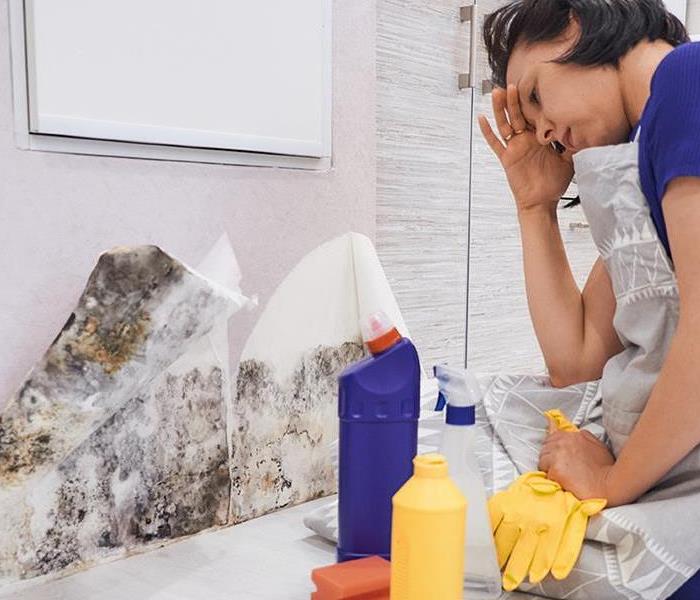 Sometimes mold is hidden behind walls or in other places where it's difficult to spot.
Sometimes mold is hidden behind walls or in other places where it's difficult to spot.
Living with mold in your home can be dangerous to your health. The sooner you get rid of it, the better. However, sometimes mold is hidden behind walls or in other places where it's difficult to spot. If you're not sure whether or not you have mold in your home, it's important to know the signs to look for.
Key Takeaways
- Musty smell and visible mold growth are signs of mold in your home.
- Have your home tested by a professional to confirm the presence of mold and determine the best way to get rid of it.
- Mold removal can be challenging and costly, but it's important to do it correctly to ensure it doesn't come back.
- Reduce the risk of mold growth by controlling humidity levels, monitoring condensation, and cleaning up spills and leaks immediately.
- Use mold-resistant products, such as paints, caulks, and tiles, to prevent mold growth.
- Treat mold by cleaning moldy surfaces, using commercial mold removal products, and repairing or replacing moldy materials.
- Call a professional if you have a lot of mold, it's growing in a difficult-to-reach area, or you have health problems that make you susceptible to mold.
- SERVPRO of East Baton Rouge and Ascension can help with your mold remediation needs, so call (225) 753-3434 to schedule a free assessment.
Signs of Mold
If you notice a musty smell in your home, it's a good indication of the presence of mold. You might also see visible mold growth. It can appear as black, green, or white patches on walls, ceilings, or other surfaces.
If you presume mold, it's essential to have your home tested by a professional. They can take samples of the air or surface areas to be certain of its presence and help you determine the best way to get rid of it.
Getting Rid of Mold
Once you've confirmed that you have mold in your home, it's important to take action to get rid of it. Mold removal can be a challenging and costly process. However, it's important to do it correctly to ensure that it doesn't come back.
If you have a small amount of mold, you might be able to remove it yourself with household cleaners and a little elbow grease. However, if you have a large amount of mold, it's best to hire a professional. They have the experience and equipment necessary to safely and effectively remove mold.
Preventing Mold
There are a few things you can do to reduce the risk of mold growth in your home:
Control Humidity Levels
Mold thrives in moist environments. To prevent growth, keep the humidity level in your home below 60%. You can do this by:
- Using a dehumidifier
- Increasing ventilation
- Fixing any leaks
Reduce Indoor Temperature Fluctuations
Temperature fluctuations can also lead to mold growth. To prevent mold, try to keep indoor temperatures as consistent as possible.
Use an air conditioner or a fan when it's hot outside, and open up windows when it's cooler to help regulate the temperature inside your home.
Monitor Condensation
Condensation can also lead to mold growth. Therefore, it is important to monitor areas of your home that are prone to condensation, such as windows, walls, and ceilings.
If you see condensation, ventilate the area, or use a dehumidifier to help reduce the moisture in the air.
Clean Up Spills and Leaks Immediately
Spills and leaks are other common sources of mold. To prevent mold, clean up any spills or leaks as soon as possible. Mop up wet floors, wipe down wet surfaces and fix any leaks to help keep your home mold-free.
Use Mold-Resistant Products
There are a variety of mold-resistant products available on the market, such as:
- Paints
- Caulks and sealants
- Bathroom and kitchen tiles
- Mold-resistant drywall
When using mold-resistant products, be sure to follow the manufacturer's instructions to ensure they are used properly.
Treating Mold
If mold is already growing in your home, you'll need to treat it to prevent the problem from getting worse.
- Clean up any moldy surfaces with soap and water
- Use a commercial mold removal product
- Repair or replace any moldy materials
When treating mold, it's important to take precautions to avoid it spreading to other areas of your home. Be sure to:
- Wear adequate protection
- Open windows and doors to provide ventilation
- Cover any moldy surfaces with plastic sheeting before cleaning
- Clean up moldy materials outside whenever possible
Taking these precautions can help prevent the spread of mold and make the job easier.
When to Call a Professional
There are some cases where it's best to call a professional to handle the problem. If you have a lot of mold, or it's growing in a difficult-to-reach area, or if you have health problems that make you susceptible to mold, it's best to call a professional.
A professional will have the experience and equipment necessary to remove mold safely and effectively. They will also be able to help you identify and fix the source of the moisture to prevent the mold from coming back.
If you think you might have a mold problem, call SERVPRO of East Baton Rouge and Ascension at (225) 753-3434 to schedule a free assessment. We're here to help with your mold remediation needs.
The Dangers of Mold in the Workplace Are Worse Than You Think
2/13/2023 (Permalink)
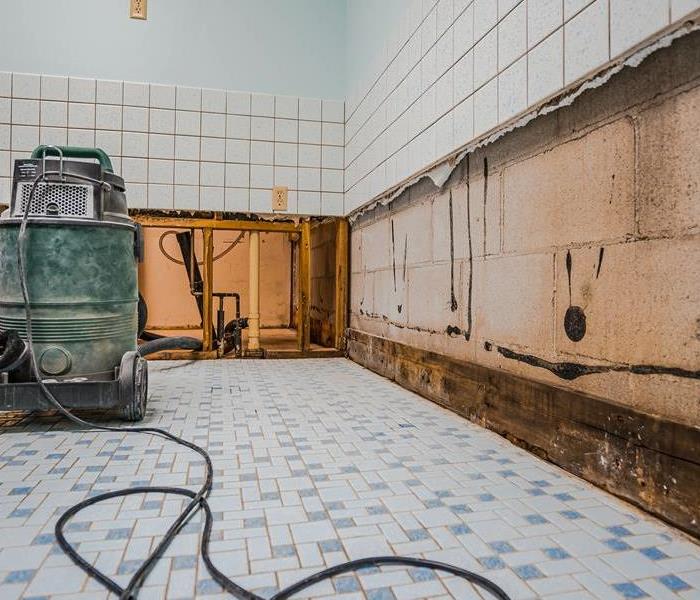 Shared food spaces or office bathrooms (shown) should be regularly checked for signs of mold or water damage.
Shared food spaces or office bathrooms (shown) should be regularly checked for signs of mold or water damage.
Mold is a common problem in homes and buildings; it thrives in areas with high humidity, such as around pipes, windows, and roof leaks, as well as in recently flooded areas. Mold thrives on cardboard, ceiling tiles, paper, and all wood products. It can grow on a wide variety of materials, including wallpaper, paint, insulation, dust, carpet, drywall, fabric, and upholstery, and spread rapidly. This is especially concerning in buildings that house large numbers of people, such as office complexes, factories, and warehouses.
Mold is a fungus that can quickly spread and become entrenched if not dealt with in a timely fashion. Whether it's a minor case of a runny nose, cough, headache, etc., or a more serious case of aspergillosis, lung irritation, etc., mold can significantly impact one's health. People who have pre-existing conditions like asthma, cystic fibrosis, COPD (Chronic Obstructive Pulmonary Disease), TB (Tuberculosis), sarcoidosis, and others are more likely to get severely affected by mold.
If any type of mold at the workplace poses a health risk to employees, it should be removed as soon as possible.
Adverse Effects of Mold
With a steady increase in population growth and in the number of people working on-site in commercial and industrial buildings, the incidence of mold-related illnesses has increased. Although this issue has been around for a while, few people realize how deadly its consequences are. Workplace mold problems should not be ignored or put at the bottom of the to-do list. This is for the health and safety of everyone in the building and of employees' families at home.
Allergies
Being present in mold-infested buildings can aggravate pre-existing allergies. Symptoms include sneezing; mouth, nose, and throat irritation; runny nose and nasal stuffiness; and red, itchy, or watery eyes. Mold can cause asthma-like symptoms in people who already have allergies, such as coughing, wheezing, or shortness of breath.
Asthma
Mold-related illnesses are also linked to asthma. Constant mold exposure can cause not only symptoms but also illnesses. In people with lung disease, irritating or sensitizing exposure causes airway inflammation. Asthma symptoms include shortness of breath, chest tightness, coughing, and wheezing.
If you suspect a mold issue in your workplace, contact a reputable clean-up firm like SERVPRO. We are highly trained in mold remediation and can quickly restore your workplace to a healthy and productive environment. For additional details, please contact us right away!
Hypersensitivity Pneumonitis
This chronic inflammatory disease, also known as HP, is caused by the sensitization of one's immune system to organic dust when inhaled. This is a serious condition that, if not treated promptly, can result in permanent lung damage. Even though it is often mistaken for regular pneumonia, antibiotics cannot be used to treat it.
Aside from the health risks, mold infestation in the workplace can lead to a variety of other disastrous consequences. Because it often goes unnoticed, it can cause significant damage to the building. They colonize so quickly that, in an unchecked scenario, they can effectively consume building materials such as drywall and wood. This can permanently damage a building's structure. Consequently, the lives of everyone in the area are in grave danger because of the possibility of a building collapse.
Extreme mold infestations can also destroy a building, leaving its owners with no choice but to demolish it. Even if the damage is not as severe, there will be a significant financial loss because tens of thousands of dollars will be spent on repairs.
As the owner, you may also face lawsuits from staff and workers who are infected with mold, which could cost millions of dollars.
According to the NIOSH (National Institute for Occupational Safety and Health), here are some preventive measures to take to avoid a mold infestation:
- To avoid high indoor humidity, use HVAC systems.
- Check buildings for dampness on a regular basis.
- Fix leaking pipes, windows, and roofs as soon as you can.
- After flooding, thoroughly clean and dry the area.
In the event of a mold infestation, the best course of action is to contact a professional remediation service immediately; attempting DIY measures will only worsen the situation. Contact a licensed and trustworthy mold removal company to help you contain the problem quickly and save yourself and your building.
If you suspect a mold problem in your office, contact a professional remediation company like SERVPRO. We specialize in mold removal and can quickly restore your workplace to a safe and healthy state. For more information, please contact us right away!
Musty, Dusty, and Other Smells That Tell Signs of Mold
12/19/2022 (Permalink)
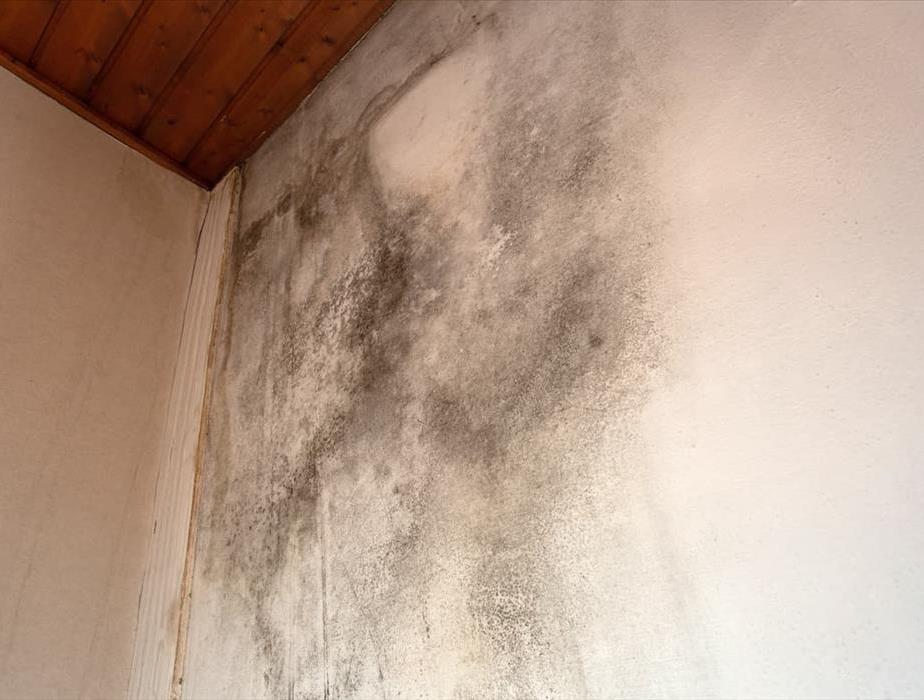 Don't let a little mold grow, as it will soon become hazardous.
Don't let a little mold grow, as it will soon become hazardous.
Mold grows best in damp, humid, and warm environments and can often be found in basements, kitchens, bathrooms, or any other area with high humidity levels or prone to water leaks. Mold spores are invisible to the naked eye and can easily become airborne, making them difficult to detect if you don't know what to look for.
Tell Tale Signs of Mold
One of the most common ways to tell if you have mold is by its distinct musty smell. This is because mold spores release a gas called mycotoxin, which can cause respiratory problems, headaches, and fatigue.
If you notice a damp, earthy, or mildew-like odor in your home, it's likely an indication of the presence of mold. However, it's important to investigate further to be certain.
Other signs of mold include visible growth on surfaces, water stains, or peeling paint.
Visible Mold Growth
Mold can appear as black, green, white, or orange patches on walls, ceilings, or floors. It can also appear as fuzzy or slimy growth. Mold often looks like stains and can be just as difficult to remove.
Water Stains
Water stains on walls, ceilings, or floors can be a sign of mold growth. These stains are usually dark in color and may be accompanied by a musty smell. These stains are commonly found in areas with high humidity or prone to water leaks, like kitchens, bathrooms, or laundry rooms.
Peeling Paint
Mold can cause paint to peel, bubble, or flake off of surfaces. This is usually a sign of extensive mold growth and should be addressed immediately.
Complaints of Allergies or Illness
If you or someone in your household starts to experience allergy-like symptoms such as a runny nose, watery eyes, coughing, or difficulty breathing, it could be a sign that mold is present. Headaches, fatigue, and nausea can also accompany these symptoms. If you notice any of these symptoms, it's important to investigate for mold and have it removed as soon as possible.
If you suspect that mold is present in your home, it's important to have it professionally inspected and removed. Mold testing kits are readily available and can be a helpful tool in detecting mold.
A professional mold remediation company will be able to properly assess the situation and recommend the best course of action. In some cases, mold can be removed with simple cleaning techniques. However, in other cases, removing and replacing affected building materials may be necessary.
No matter what the situation is, it's important to act quickly if you suspect the presence of mold in your home.
What to Do if You Have Mold
If you suspect mold is growing in your home, it's important to take action immediately to prevent the problem from worsening.
The first thing you should do is isolate the area. This means ensuring that the area is well-ventilated and that any air ducts are turned off. You should also avoid using any fans or other devices that could spread mold spores.
The next step is to clean the area. Mold can be removed with various household cleaners, but it's important to make sure that you're using cleaners specifically designed to kill mold.
You should also wear protective gear such as gloves, a mask, and eye protection to avoid coming into contact with mold spores.
Once the area is clean, you should take steps to prevent mold from returning. This means fixing any leaks, repairing any water damage, and keeping the area well-ventilated. You should also monitor the area for signs of mold growth and act quickly if you notice any.
Mold can be a serious problem in your home, but it doesn't have to be. With proper detection and removal, you can rid your home of mold and keep it from coming back.
By preventing mold growth in your home, you can avoid the health problems and damage it can cause. Be sure to keep an eye out for signs of mold and take action immediately if you find it.
When to Contact a Professional
Sometimes, it's best to leave mold remediation to professionals. If you have a large amount of mold, if mold is growing in a hard-to-reach area, or if you have a weakened immune system, it's best to contact a professional for help.
Contact SERVPRO of East Baton Rouge at (225) 753-3434 for assistance. We have the training, experience, and equipment to handle any mold problem, no matter how big or small. We will work quickly and discreetly to get your home back to normal.
Health Dangers of Mold
5/24/2019 (Permalink)
When you notice mold growing in your home, the spot may look like nothing more than a nuisance. But for many people, mold can present a wide range of health risks — particularly when the problem is widespread. To help you protect your household — and recognize the importance of mold remediation — here are few important details to know about how this type of fungus can harm the body.
A GUIDE TO THE HAZARDS OF MOLD.
How Does Mold Affect Health?
As this variety of fungus grows, it produces microscopic spores that can spread through your home. When inhaled, individuals with sensitivities to mold may experience chronic breathing problems, skin irritation, and congestion.
These reactions are typically more common among those with allergies or asthma. When people have compromised immune systems, mold-related health problems can lead to infections, such as those affecting the lungs. In addition to putting human health in danger, mold growth is also known to similarly affect pets.
How Can You Prevent Mold-Related Health Problems?
The best way to avoid these health risks is to limit the amount of moisture in your home, as this fungus thrives in damp, humid conditions. Some approaches to DIY mold remediation include fixing leaks, using a dehumidifier, and insulating windows to prevent condensation. If your home is subject to water damage, call SERVPRO of East Baton Rouge (225-753-3434) to thoroughly dry and clean the area.
What Should You Do If You Spot Mold in Your Home?
Even by following the above steps, it’s likely that you will encounter this problem at some point. If the issue is small and contained, you can usually tackle it on your own by washing the surface with a soap and water solution. However, if you face recurring or widespread growth, call SERVPRO of East Baton Rouge at 225-753-3434 today for a FREE assessment.
If mold is putting your household’s health at risk, the trusted professionals at SERVPRO of East Baton Rouge, will put your home on the path to wellness. As leading mold remediation and restoration service experts, we know how to tackle mold growth strategically. Equipped with heavy-duty cleaning tools, our crews will not only remove spots, but also implement solutions to control moisture and prevent the problem from returning. To arrange fast and effective clean-up, call a helpful representative at 225-753-3434 today.
Does your East Baton Rouge Home Have a Mold Problem?
7/23/2018 (Permalink)
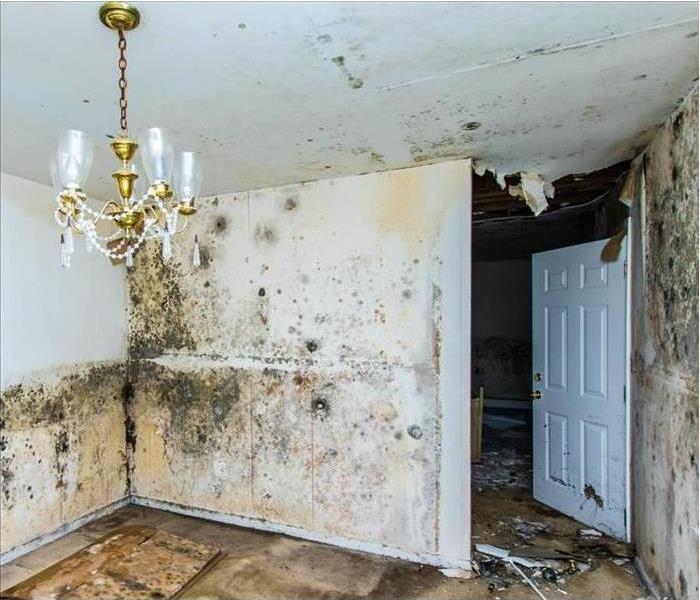 Call today for your mold damage problems 225-753-3434
Call today for your mold damage problems 225-753-3434
Microscopic mold spores naturally occur almost everywhere, both outdoors and indoors. This makes it impossible to remove all mold from a home or business. Therefore, mold remediation reduces the mold spore count back to its natural or baseline level. Some restoration businesses advertise “mold removal” and even guarantee to remove all mold, which is a fallacy. Consider the following mold facts:
- Mold is present almost everywhere, indoors and outdoors.
- Mold spores are microscopic and float along in the air and may enter your home through windows, doors, or AC/heating systems or even hitch a ride indoors on your clothing or a pet.
- Mold spores thrive on moisture. Mold spores can quickly grow into colonies when exposed to water. These colonies may produce allergens and irritants.
- Before mold remediation can begin, any sources of water or moisture must be addressed. Otherwise, the mold may return.
- Mold often produces a strong, musty odor and can lead you to possible mold problem areas.
- Even higher-than-normal indoor humidity can support mold growth. Keep indoor humidity below 45 percent.
If your home or business has a mold problem, we can inspect and assess your property and use our specialized training, equipment, and expertise to remediate your mold infestation.
We Answer the Phone Ready to Help
Call Today – 225-753-3434
Mold 101
6/22/2018 (Permalink)
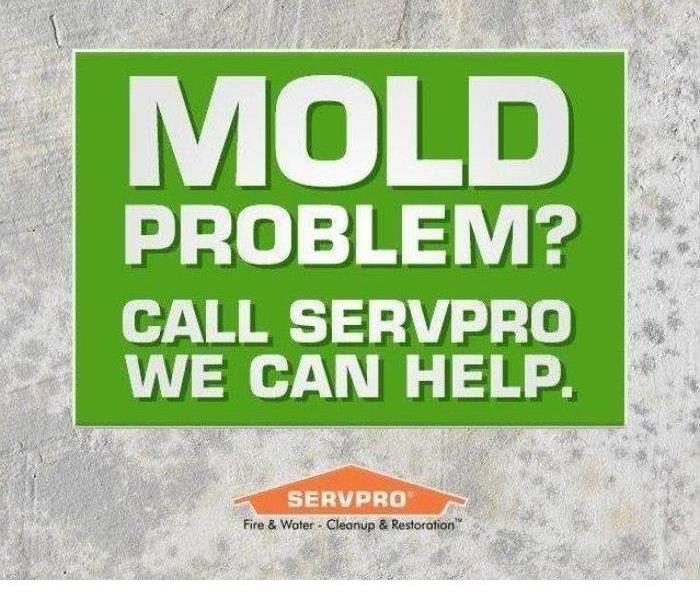 Don't let mold spread contact SERVPRO of East Baton Rouge today 225-753-3434
Don't let mold spread contact SERVPRO of East Baton Rouge today 225-753-3434
Here what you need to know about mold
Microscopic mold spores naturally occur almost everywhere, both outdoors and indoors. This makes it impossible to remove all molds from a home or business. Therefore, mold remediation reduces the mold spore count back to its natural or baseline level. Some restoration businesses advertise “mold removal” and even guarantee to remove all molds, which is a fallacy. Consider the following mold facts:
- Mold is present almost everywhere, indoors and outdoors.
- Mold spores are microscopic and float along in the air and may enter your home through windows, doors, or AC/heating systems or even hitch a ride indoors on your clothing or a pet.
- Mold spores thrive on moisture. Mold spores can quickly grow into colonies when exposed to water. These colonies may produce allergens and irritants.
- Before mold remediation can begin, any sources of water or moisture must be addressed. Otherwise, the mold may return.
- Mold often produces a strong, musty odor and can lead you to possible mold problem areas.
- Even higher-than-normal indoor humidity can support mold growth. Keep indoor humidity below 45 percent.
If your home or business has a mold problem, we can inspect and assess your property and use our specialized training, equipment, and expertise to remediate your mold infestation.
We Answer the Phone Ready to Help
Call Today – 225-753-3434
Mold Remediation by SERVPRO of East Baton Rouge
6/22/2018 (Permalink)
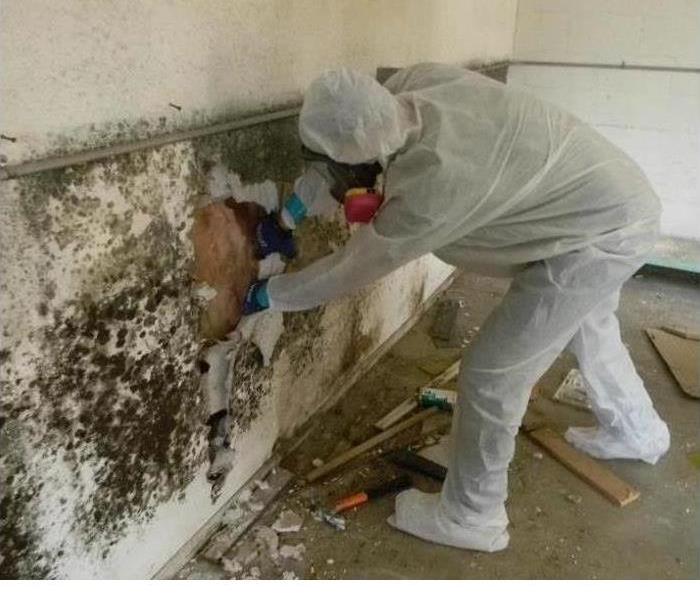 Let the pros handle your next mold problem, call SERVPRO of East Baton Rouge today 225-753-3434
Let the pros handle your next mold problem, call SERVPRO of East Baton Rouge today 225-753-3434
Mold Remediation Process
SERVPRO of East Baton Rouge understands mold and mold growth and has the training and expertise to remediate the mold in your home or business. Every mold situation is different but, the general remediation process is the same.
Steps listed below illustrate our “typical” process:
- Emergency Contact - (225)753-3434
The mold cleanup and restoration process begins when you call us. Our representative will ask a series of questions to help us determine the necessary equipment, resources, and personnel.
- Inspection and Mold Damage Assessment
We carefully inspect your property for visible signs of mold. Mold feeds on cellulose and water and can be hidden from plain view. We use various technologies to detect mold and hidden water sources.
- Mold Containment
Our professionals use various containment procedures to prevent the spread of mold. We may use advanced containment procedures like negative air chambers to isolate the contaminated area with physical barriers and negative air pressure to keep the mold spores from spreading during the cleanup process. All fans and heating and cooling systems will be turned off to prevent the spread of mold.
- Air Filtration
Our specialized filtration equipment allows our Professionals to capture microscopic mold spores out of the air. We utilize powerful “air scrubbers” and HEPA vacuums to prevent the spread of these mold spores while the mold remediation is in process.
- Removing Mold and Mold-Infested Materials
The mold remediation process depends on the amount of mold growth and the types of surfaces on which the mold appears. We’ll use antifungal and antimicrobial treatments to eliminate mold colonies and to help prevent new colonies from forming. It may be necessary to remove and dispose of mold-infested porous materials, like drywall and carpeting, to remediate heavy mold growth.
- Cleaning Contents and Belongings
We clean your furniture, decorative items, curtains, clothing, and other restorable items affected by mold. We use a variety of cleaning techniques to clean and disinfect your belongings. We’re also trained to remove odors and deodorization using fogging equipment.
- Restoration
Depending on the level of mold damage, drywall, subfloors, and other building materials may have been removed. Restoration may involve minor repairs, such as replacing drywall, painting, and installing new carpet; or it may entail major repairs such as the reconstruction of various areas or rooms in a home or business. The restoration step gets your home or business back to normal.
About SERVPRO of East Baton Rouge
SERVPRO of East Baton Rouge specializes in the cleanup and restoration of residential and commercial property after a fire, smoke or water damage event. Our staff is highly trained in property damage restoration. From initial and ongoing training at SERVPRO’s corporate training facility to regular IICRC-industry certification, rest assured our staff is equipped with the knowledge to restore your property.
We Answer the Phone Ready to Help
Call Today – 225-753-3434
Mold in Heating Ducts
6/12/2018 (Permalink)
Mold In Heating Ducts
Mold in heating ducts is a serious problem. Of course, household mold is never a good thing, no matter where in the home it's found. Exposure to mold has been linked to health effects and it can literally eat away at some building materials, including wood. There are a few reasons mold in heating, ventilation and air conditioning ducts is particularly problematic, though. We'll tell you why it's such a bad thing and what to do if you think you may have mold in your heating ducts.
You Can't See It
Mold can grow unseen in heating ducts for a long time before you ever realize it's there. Even if you suspect you have mold in your home and look for it, you might miss mold in your heating ducts. It can be hard to see even if you try to look in your heating ducts, since only a small portion of the duct work in your home can be seen without special equipment. Even if you can't see it, though, mold in your heating ducts can grow and spread and make you sick.
It Can Easily Spread Throughout The House
Most strains of mold grow and spread easily. The duct work that runs through your house provides a pathway for mold to move easily from room to room, throughout the whole house. Turning on the heat helps mold move through the duct work even faster, as the forced air carries the mold spores effortlessly along. Even worse, when the heat is turned on, the air blowing through the vents carries mold spores into every room. In no time at all, you could have mold throughout the entire house.
Mold In Heating Ducts Is Difficult To Remove
It's one thing to clean mold off shower stalls or to remove moldy carpet from a room. It is another thing to remove mold in heating ducts. While mold can be removed from nonporous surfaces like metal or fiberglass heating ducts, it's difficult to reach the ducts in order to clean them.
The U.S. Environmental Protection Agency (EPA) recommends calling in a professional if you need to have mold removed from your heating ducts and we definitely agree. Special equipment is needed for the job, including manual or mechanical brushes, blowguns or air skippers that drive mold particles and other debris toward a collection device, a vacuum with a HEPA (high-efficiency particulate air) filter to remove potentially harmful mold and other contaminants from the heating ducts, and negative air pressure devices that create negative pressure within the duct work so that mold spores are unable to drift into other areas during the mold removal process. The job must also be done carefully in order to avoid inadvertently damaging the duct work in the process.
Look for a professional that is certified by, or at least adheres to the standards established by, the National Air Duct Cleaners Association. If you have fiberglass ducts or fiberglass liners in your ducts, look for a professional that also is familiar with and follows the cleaning procedures established by the North American Insulation Manufacturers Association. Many techniques commonly used to clean heating ducts can damage fiberglass, so it is important to choose a professional with the skills and experience needed to properly clean fiberglass ducts.
Until you can get a professional to look at your heating ducts, don't turn on the heat!
Making Sure Mold In Heating Ducts Has Been Removed Completely
The Environmental Protection Agency suggests having your home tested for mold after mold remediation has been completed and we think that is especially important after having mold removed from your heating ducts. You want to make sure no mold remains in the duct work because if even a little bit of mold remains, it can grow and spread throughout the home again. Make sure you find a professional mold tester that adheres to the standards established by professional organizations like the American Industrial Hygiene Association or the American Conference of Governmental Industrial Hygienists.
Note that you want to hire a professional mold tester who is not affiliated in any way with any company or professional performing mold remediation in your home or cleaning the heating ducts in your home. You want someone completely independent and objective.
Inspecting For Mold
Having your heating ducts cleaned may not be enough to ensure your home is free of potentially hazardous mold. Since mold spreads easily, especially through heating ducts, we recommend checking the rest of your home for mold. A professional mold tester can test the rest of your home or you can schedule a free inspection by a mold removal specialist. If any additional mold is found, the mold removal professional will provide a written estimate for the work and answer any questions you may have.
We Answer the Phone Ready to Help
Call Today – 225-753-3434
Understanding the Mold Remediation Process
6/12/2018 (Permalink)
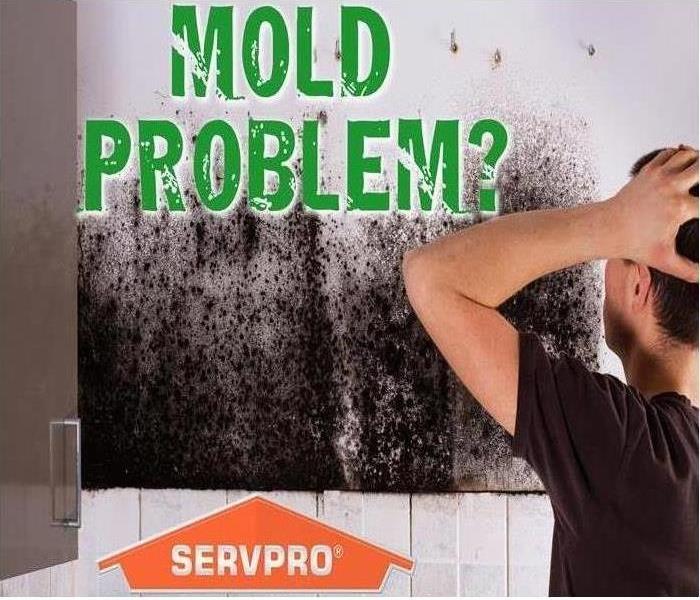 Mold Problem? Call SERVPRO of East Baton Rouge 225-753-3434.
Mold Problem? Call SERVPRO of East Baton Rouge 225-753-3434.
MOLD REMEDIATION
Every mold damage scenario is different and requires a unique solution, but the general mold remediation process stays the same. The steps listed below illustrate our “typical” process:
- Emergency Contact - (225) 753-3434
The mold cleanup and restoration process begins when you call us. Our representative will ask a series of questions to help us determine the necessary equipment, resources, and personnel.
- Inspection and Mold Damage Assessment
We carefully inspect your property for visible signs of mold. Mold feeds on cellulose and water and can be hidden from plain view. We use various technologies to detect mold and hidden water sources.
- Mold Containment
Our professionals use various containment procedures to prevent the spread of mold. We may use advanced containment procedures like negative air chambers to isolate the contaminated area with physical barriers and negative air pressure to keep the mold spores from spreading during the cleanup process. All fans and heating and cooling systems will be turned off to prevent the spread of mold.
- Air Filtration
Our specialized filtration equipment allows our Professionals to capture microscopic mold spores out of the air. We utilize powerful “air scrubbers” and HEPA vacuums to prevent the spread of these mold spores while the mold remediation is in process.
- Removing Mold and Mold-Infested Materials
The mold remediation process depends on the amount of mold growth and the types of surfaces on which the mold appears. We’ll use antifungal and antimicrobial treatments to eliminate mold colonies and to help prevent new colonies from forming. It may be necessary to remove and dispose of mold-infested porous materials, like drywall and carpeting, to remediate heavy mold growth.
- Cleaning Contents and Belongings
We clean your furniture, decorative items, curtains, clothing, and other restorable items affected by mold. We use a variety of cleaning techniques to clean and disinfect your belongings. We’re also trained to remove odors and deodorization using fogging equipment.
- Restoration
Depending on the level of mold damage, drywall, subfloors, and other building materials may have been removed. Restoration may involve minor repairs, such as replacing drywall, painting, and installing new carpet; or it may entail major repairs such as the reconstruction of various areas or rooms in a home or business. The restoration step gets your home or business back to normal.
About SERVPRO of East Baton Rouge
SERVPRO of East Baton Rouge specializes in the cleanup and restoration of residential and commercial property after a fire, smoke or water damage event. Our staff is highly trained in property damage restoration and we are an IICRC Certified Firm. We believe in continuous training: from initial and ongoing training at SERVPRO’s corporate training facility to regular IICRC-industry certification, rest assured our staff is equipped with the knowledge to restore your property.
We Answer the Phone Ready to Help
Call Today – 225-753-3434
How To Kill Mold In Carpet
5/29/2018 (Permalink)
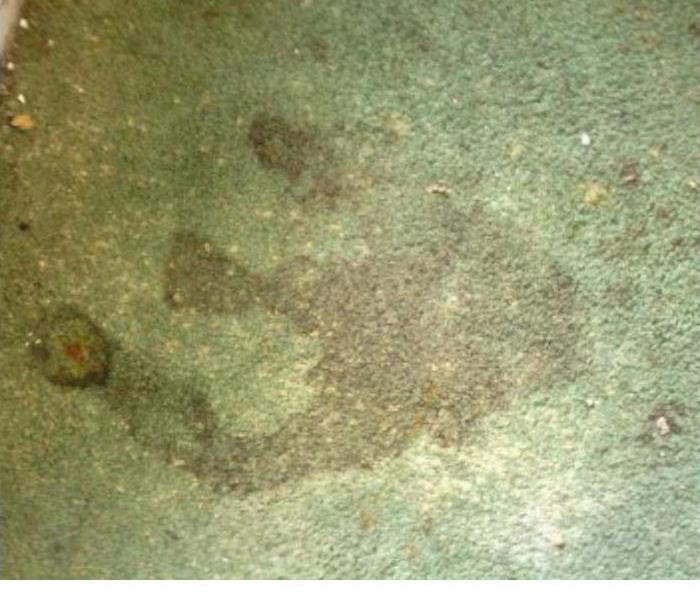 Carpet With Mold
Carpet With Mold
How To Kill Mold In Carpet
It is nearly impossible to kill mold in carpets. Unfortunately, mold gets into the carpet fibers and even if it looks as if you've removed the mold, it is very likely small amounts remain.
You're probably aware of the many health risks associated with mold in the home and it is important to remove mold thoroughly from all household materials. We'll tell you what to do if you've got moldy carpet in your home so that you can protect your health and the health of your family.
Why Can't You Kill Carpet Mold?
There are numerous products available that kill mold, but none are very effective when used in an attempt to kill mold in carpet. Why not? Well, carpet, like all types of fabric, is made of tiny fibers twisted together to make thread and then woven together to create a type of fabric. While there are many different styles of carpet, all are made from fibers spun into thread, which is then woven into carpet.
When fibers are twisted and woven together, tiny spaces are left between the fibers. Microscopic mold spores can get into those spaces and it is virtually impossible to remove them. If you scrub the moldy carpet, you may not be able to see any more mold, but tiny amounts will still remain.
What Happens When Mold In Carpet Is Not Completely Removed?
Most strains of mold grow pretty quickly and also spread easily, so if even small traces of mold remain in the carpet, you may find yourself dealing with a serious mold problem again in the future. Mold may begin to grow beneath the carpet and can ruin your floorboards. It can also spread to other areas of the home. If it enters your heating and air conditioning ducts, it will quickly spread throughout the entire house as soon as you turn on your heat or air conditioning.
Of course, the continued presence of even small amounts of mold in your carpet will continue to pose a health risk. The longer you are exposed to mold, the greater the risk to your health.
If You Can't Kill Mold In Carpet, How Do You Deal With It?
Since you cannot kill carpet mold completely, you need to remove mold carpet and replace it. It's the only way to make sure your home is free of potentially harmful mold.
Moldy carpet must be removed carefully, though, to avoid spreading mold spores throughout the room.
First the work area should be prepared by taping heavy plastic over heating and air conditioning vents and any open doorways. This prevents mold spores from drifting into other rooms or entering your HVAC system.
Then the carpet should be pulled up carefully and sealed in heavy plastic bags before it is carried out of the house. The padding beneath the carpet will most likely need to be removed as well. If the floorboards beneath the carpet and padding are moldy, they will also need to be removed and replaced.
Pulling up moldy carpet sends hundreds of thousands of microscopic mold spores flying into the air, where they are easily inhaled. Cutting into moldy floorboards in order to remove and replace them has the same effect. This exposure to mold can cause all sorts of health problems. In fact, it is recommended that if your health is compromised in any way, you avoid removing moldy carpet or handling other aspects of mold removal on your own. The U.S. Environmental Protection Agency (EPA) recommends checking with your doctor if you have any questions or concerns about whether or not it is safe for you to remove mold on your own.
Appropriate safety gear must be worn while removing moldy carpet, including disposable gloves, hair covers, shoe covers, and an N-95 face mask. Long pants and long sleeves should be worn and clothing should be laundered in hot water as soon as the mold removal work is completed.
For Help Dealing With Moldy Carpet
As you can see, since you can't kill mold in carpet and instead must remove and replace it, dealing with moldy carpet is a pretty big job. The job is made even bigger and further complicated if you must remove and replace floorboards. If you need help with the job, or if your doctor recommends you not handle moldy carpet yourself due to health concerns.
We Answer the Phone Ready to Help
Call Today – 225-753-3434
What Causes Mold In The Home
5/24/2018 (Permalink)
What Causes Mold In The Home
The short answer to the question of what causes mold is moisture. Mold cannot grow without moisture, although some types of mold need more moisture than others. Most types of mold also grow best in warm environments, although some types grow fairly well in cool places, as well.
Microscopic mold spores are all around us, both indoors and out. Mold spores can remain viable for a very long time in cool dry places; then, when water is introduced, mold begins to grow.
Mold typically grows quickly and spreads easily. Mold grows as mold spores reproduce and it spreads as the tiny, lightweight mold spores float on the air or are carried from place to place by people or animals.
Causes of household mold usually involve water or moisture in areas of the home that should be dry. For instance, a small leak under the kitchen sink can provide the necessary moisture for mold to begin to grow. Mold can then spread from beneath the sink to other areas of the kitchen, and from there, to other areas of the home.
What Causes Mold?
Excessive moisture often leads to mold. Excessive moisture in a home may be due to a number of factors, including:
- A leak in the roof
- A leaky pipe or a broken pipe
- Leaks under sinks or behind toilets
- Leaky hoses on washing machines or dish washers
- Poor ventilation in bathrooms or kitchens
- Poorly-ventilated attics
- Overflowing sinks, tubs or toilets
- Poor drainage in the land around a home
- Lack of insulation, leading to condensation inside the home
- Missing grout between shower tiles
Preventing What Causes Mold
To prevent excessive moisture that can lead to the development of mold, the Federal Emergency Management Agency (FEMA) recommends taking these steps.
- Install exhaust fans in bathrooms and kitchens and use them when showering and cooking.
- Don’t use carpet in bathrooms or kitchens.
- If you have throw rugs in your bathroom, hang them up to dry whenever they get damp.
- Clean up water spills promptly.
- If you notice stains of walls or ceilings, or other signs of water leaks, address the issue promptly.
- Check periodically for leaks under sinks, behind toilets, and around appliances like washing machines and dish washers. Address any leaks promptly.
- Make sure rain gutters drain water away from the house.
- Land around the house should also slope away from the house so that water drains away from the building.
- Use large sheets of plastic to cover dirt in crawlspaces to prevent moisture from the ground from entering your home.
- Use mold-resistant paint in areas with high humidity, such as bathrooms and kitchens.
- Use other mold-resistant, water-resistant materials, like stainless steel fixtures, waterproof wallboard, tile, stone and deep-sealed concrete, in areas with high humidity.
- Install dehumidifiers in areas with high humidity.
- Use air conditioners or fans in hot weather to keep the humidity down. Don’t use fans in areas where mold is growing, though, because that can spread mold spores and make the problem worse. Don’t run your air conditioner if there is mold in your air conditioning ducts, either, because that will spread mold to other areas of the home.
Finding The Causes Of Household Mold
If you have mold in your home, it’s important not only to remove the mold but to determine the cause of the mold and fix that problem. Otherwise, mold can quickly return after you clean it up.
You’ll need to inspect your home thoroughly in order to find all sources of mold. Don’t assume there is only one source of excess moisture. Check all possible sources, including under sinks, behind toilets, around tops, under and behind dish washers and washing machines, around windows, in basements and crawlspaces, and in attics.
If you’re not sure what led to the growth of mold in your home, a mold remediation professional can assist you in figuring it out and advise you about how to correct the problem.
For more information give us a call at (225)-753-3434 or visit our website
www.SERVPROeastbatonrougela.com
Baton Rouge, Got Mold? Do's and Not to Do's
6/9/2017 (Permalink)
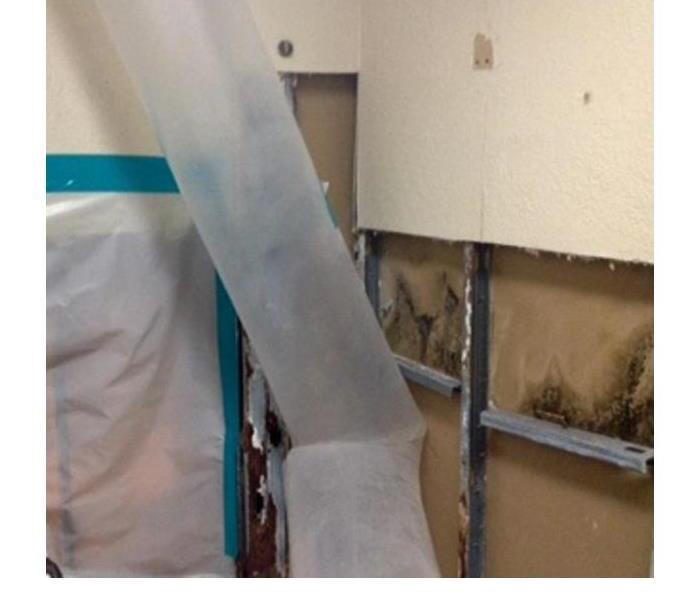 This particular mold problem was caused from trapped moisture in the wall cavities.
This particular mold problem was caused from trapped moisture in the wall cavities.
Mold can cause health effects and can also cause significant damage to your property. SERVPRO of East Baton Rouge has the training, protective gear, and specialized equipment necessary to handle your mold problem.
If you have a mold problem in your home or business, consider the following facts:
- Significant mold growth can occur in 48-72 hours.
- Mold may present a greater risk to children, the elderly, and anyone with respiratory problems.
- A strong, musty odor may indicate hidden mold behind drywall or under carpeting.
What to Do:
- Stay out of affected areas.
- Turn off the HVAC system and fans.
- Contact SERVPRO of East Baton Rouge for mold remediation services.
What Not to Do:
- Don’t touch or disturb the mold.
- Don’t blow air across any surfaces with visible or suspected mold growth.
- Don’t attempt to dry the area yourself.
- Don’t spray bleach or other disinfectants on the mold.
Mold Remediation Services
If you suspect that your home or business has a mold problem, SERVPRO of East Baton Rouge has the training, equipment, and expertise to handle the situation.
About SERVPRO of East Baton Rouge
SERVPRO of East Baton Rouge specializes in the cleanup and restoration of residential and commercial property after a fire, smoke or water damage event. Our staff is highly trained in property damage restoration. From initial and ongoing training at SERVPRO’s corporate training facility to regular IICRC-industry certification, rest assured our staff is equipped with the knowledge to restore your property.
Have a Mold Problem?
Call Us Today – (225) 753-3434
7 Steps to the Mold Remediation Process in Baton Rouge
6/9/2017 (Permalink)
SERVPRO of East Baton Rouge understands mold and mold growth and has the training and expertise to remediate the mold in your home or business. Every mold situation is different but, the general remediation process is the same.
Steps listed below illustrate our “typical” process:
- Emergency Contact - (225)753-3434
The mold cleanup and restoration process begins when you call us. Our representative will ask a series of questions to help us determine the necessary equipment, resources, and personnel.
- Inspection and Mold Damage Assessment
We carefully inspect your property for visible signs of mold. Mold feeds on cellulose and water and can be hidden from plain view. We use various technologies to detect mold and hidden water sources.
- Mold Containment
Our professionals use various containment procedures to prevent the spread of mold. We may use advanced containment procedures like negative air chambers to isolate the contaminated area with physical barriers and negative air pressure to keep the mold spores from spreading during the cleanup process. All fans and heating and cooling systems will be turned off to prevent the spread of mold.
- Air Filtration
Our specialized filtration equipment allows our Professionals to capture microscopic mold spores out of the air. We utilize powerful “air scrubbers” and HEPA vacuums to prevent the spread of these mold spores while the mold remediation is in process.
- Removing Mold and Mold-Infested Materials
The mold remediation process depends on the amount of mold growth and the types of surfaces on which the mold appears. We’ll use antifungal and antimicrobial treatments to eliminate mold colonies and to help prevent new colonies from forming. It may be necessary to remove and dispose of mold-infested porous materials, like drywall and carpeting, to remediate heavy mold growth.
- Cleaning Contents and Belongings
We clean your furniture, decorative items, curtains, clothing, and other restorable items affected by mold. We use a variety of cleaning techniques to clean and disinfect your belongings. We’re also trained to remove odors and deodorization using fogging equipment.
- Restoration
Depending on the level of mold damage, drywall, subfloors, and other building materials may have been removed. Restoration may involve minor repairs, such as replacing drywall, painting, and installing new carpet; or it may entail major repairs such as the reconstruction of various areas or rooms in a home or business. The restoration step gets your home or business back to normal.
About SERVPRO of East Baton Rouge
SERVPRO of East Baton Rouge specializes in the cleanup and restoration of residential and commercial property after a fire, smoke or water damage event. Our staff is highly trained in property damage restoration. From initial and ongoing training at SERVPRO’s corporate training facility to regular IICRC-industry certification, rest assured our staff is equipped with the knowledge to restore your property.
Have questions about the Mold Remediation Process? Call us today - (225)753-3434





 24/7 Emergency Service
24/7 Emergency Service

